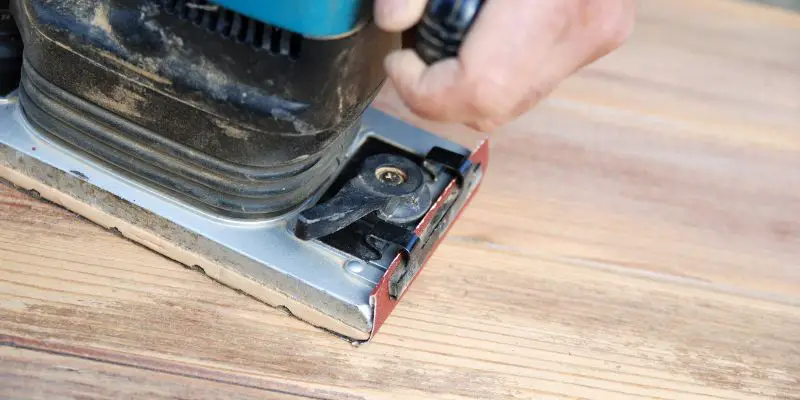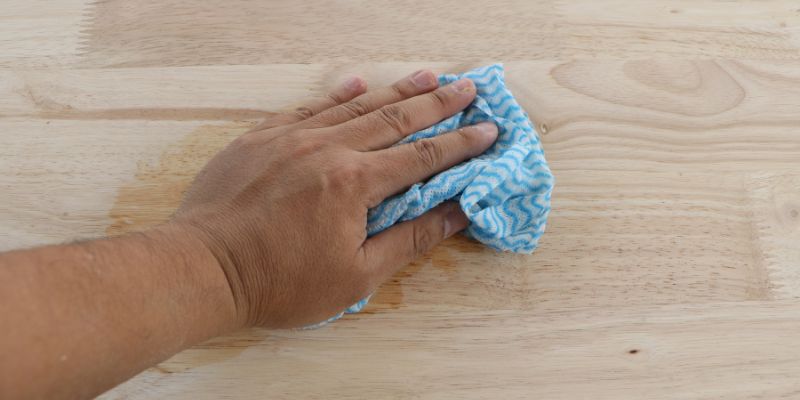To get acrylic paint off wood, use a mixture of warm water and mild dish soap, rubbing it gently on the paint until it comes off. In some cases, using rubbing alcohol or denatured alcohol can be effective as well.
Preparation
Looking to remove acrylic paint from wood surfaces? Here’s a simple guide: Start by scraping off excess paint with a plastic putty knife, then use a mixture of dish soap and water to clean the area. Gently scrub with a soft-bristled brush, rinse, and repeat if necessary.
Gathering Necessary Supplies
Before you start the process of removing acrylic paint from wood, it’s important to gather all the necessary supplies. Having everything on hand will save you time and ensure a smooth removal process. Here are the supplies you’ll need:
- Isopropyl alcohol or denatured alcohol
- Clean cloth or sponge
- Plastic wrap or aluminum foil
- Plastic scraper or putty knife
- Neutral soap or detergent
- Water
- Vinegar (optional)
- Fine-grit sandpaper (optional)
- Protective gloves
Having these supplies ready will help you to seamlessly tackle the task at hand.
Protecting The Surrounding Area
Before you get started with removing the acrylic paint, it’s crucial to protect the surrounding area to prevent any damage. Even the most skilled painters can have accidents, so it’s better to be safe than sorry. Here’s how you can protect the area around the painted wood surface:
- Cover the floor or work surface with plastic sheets or drop cloths to catch any spills or drips.
- If the wood is near furniture or other objects, considering covering them or moving them out of the way to avoid any accidental damage.
- Apply painter’s tape along the edges of the painted wood to create a barrier and prevent the paint from spreading.
- Consider using old newspapers or cardboard to create a protective layer under the wood surface.
By taking the time to properly protect the surrounding area, you can ensure that your paint removal process goes smoothly without any unintended consequences.
Remember, preparation is key when it comes to removing acrylic paint from wood. By gathering all the necessary supplies and protecting the surrounding area effectively, you can set yourself up for success and make the process easier and more efficient.

Techniques For Removing Acrylic Paint
Acrylic paint can add a vibrant pop of color to any wooden surface, but what happens when you need to remove it? Don’t worry, we’ve got you covered with several effective techniques for removing acrylic paint from wood. Whether you prefer using heat and scraping, applying solvents, or using sandpaper, there’s a method that suits your preferences and the needs of your project. Read on to discover how to easily remove acrylic paint without damaging the wood.
Using Heat And Scraping
One of the most widely used methods for removing acrylic paint from wood is using heat and scraping. This technique involves softening the paint with heat and then gently scraping it away. Here’s how you can do it:
- Preheat an iron on a low setting.
- Place a cloth or paper towel over the painted area.
- Gently press the heated iron onto the cloth, moving it around in circular motions for about 10-15 seconds. This will help soften the paint.
- Quickly remove the cloth and use a plastic scraper or a blunt knife to scrape off the softened paint. Be careful not to scratch the wood.
- If there are any stubborn traces of paint left, repeat the process until the wood surface is clean.
Applying Solvents
When heat and scraping don’t do the trick, you can turn to solvents to remove acrylic paint from wood. Solvents help break down and dissolve the paint, making it easier to wipe away. Follow these steps to effectively use solvents:
- Choose a suitable solvent, such as rubbing alcohol or mineral spirits. Make sure to test a small, inconspicuous area first to ensure it won’t damage the wood.
- Dampen a cloth or sponge with the chosen solvent.
- Gently rub the cloth or sponge on the painted area, applying gentle pressure. The solvent will start to loosen the paint.
- Continue to wipe away the dissolved paint with a clean cloth or sponge. You may need to repeat the process several times to remove all the paint.
- Once the paint is completely removed, clean the wood surface with mild soap and water to eliminate any residue.
Using Sandpaper
If you’re dealing with a thicker layer of acrylic paint or if the above methods don’t completely remove the paint, using sandpaper can help you achieve a smooth and paint-free wood surface. Here’s how to do it:
- Select sandpaper with a grit suitable for your needs. Coarse grits (60-80) are effective for removing thick layers of paint, while fine grits (120-220) are ideal for smoothing out the wood surface.
- Wrap the sandpaper around a sanding block or use it with your hand.
- Sand the painted area in a gentle, circular motion. Be careful not to apply too much pressure, as it may damage the wood.
- Continue sanding until the paint is completely removed and the wood appears smooth.
- Wipe away any residual paint and sanding dust with a clean cloth.
When it comes to removing acrylic paint from wood, these techniques can help you achieve excellent results. Whether you opt for using heat and scraping, applying solvents, or using sandpaper, be sure to take the necessary precautions to protect yourself and the wood surface. Now that you’re equipped with these techniques, you can confidently tackle any paint removal project.
Cleanup And Final Steps
Once you have successfully removed the majority of acrylic paint from your wood surface, it’s time to move on to the cleanup and final steps. Follow these important guidelines to ensure your wood is clean, restored, and protected for future use.
Removing Residue From The Wood Surface
While you may have already removed most of the acrylic paint, it’s common for some residue to remain on the wood surface. To get rid of any leftover paint and ensure a smooth finish, you can use various methods:
- Warm soapy water: Create a solution of warm water and a mild soap. Use a sponge or soft cloth to gently scrub the affected area in circular motions. Rinse the surface thoroughly and pat it dry.
- Vinegar: Mix equal parts of white vinegar and water. Dampen a cloth with the solution and gently rub the residue until it loosens. Rinse the wood and dry it with a clean cloth.
- Rubbing alcohol: Moisten a cloth or cotton ball with rubbing alcohol and carefully dab it onto the leftover paint. Gently scrub the area until the residue is removed. Wipe the wood clean with a damp cloth afterward.
- Acetone: Apply a small amount of acetone to a cloth and use it to remove stubborn acrylic paint residue. Take caution when using acetone, as it may potentially damage the wood surface. Test it on a small, inconspicuous area before applying it to the entire surface.
Sanding And Refinishing
If the acrylic paint has left behind stubborn stains or marks on the wood, sanding and refinishing can help restore its original appearance. Follow these steps:
- Sand the surface: Use fine-grit sandpaper to gently sand the affected area, moving in the direction of the wood grain. This will help remove any remaining paint and smoothen the wood surface.
- Clean and dust: After sanding, wipe the wood clean with a damp cloth to remove any dust or debris. Ensure the surface is completely dry before moving on to the next step.
- Apply a wood finish: Depending on your preference, you can choose to apply wood stain or varnish to protect and enhance the appearance of the wood. Follow the manufacturer’s instructions and apply the finish evenly using a brush or cloth. Allow it to dry thoroughly before using the wood.
Protecting The Wood For Future Use
To ensure your wood remains protected from acrylic paint and other damages in the future, consider taking these measures:
- Apply a sealant: Once the wood finish has dried, consider applying a clear sealant for extra protection. This will create a barrier between the wood and any potential spills or stains.
- Use protective mats or coasters: When placing objects or containers on the wood surface, use mats or coasters to prevent any direct contact with paint or other substances.
- Regular cleaning: Clean your wood regularly using a gentle cleaner and a soft cloth to remove any dirt or grime. Avoid using harsh chemicals or abrasive tools that can damage the wood.
- Store items properly: If you need to store items on the wood surface, ensure they are placed in a way that minimizes the risk of spills or leaks. Consider using trays or containers to contain any potential mess.
By following these steps and maintaining proper care for your wood, you can ensure its longevity and beauty even after encountering accidental acrylic paint spills.

Frequently Asked Questions For How To Get Acrylic Paint Off Wood
How Do You Get Dried Acrylic Paint Off Wood?
To remove dried acrylic paint from wood, you can gently scrape it off using a plastic scraper or a credit card. If the paint is stubborn, try moistening it with warm soapy water and then scrape it off. Avoid using harsh chemicals or excessive force to prevent damage to the wood surface.
What Removes Dried Acrylic Paint?
To remove dried acrylic paint, use isopropyl alcohol or denatured alcohol. Soak a cloth or sponge in the alcohol and scrub the paint until it loosens. You can also use a scraping tool or a razor blade to gently scrape off the paint.
Is Acrylic Paint Permanent On Wood?
Yes, acrylic paint is permanent on wood. It adheres well, dries quickly, and creates a strong bond.
Does Acrylic Paint Peel Off Wood?
Yes, acrylic paint can peel off wood if it is not properly prepared or sealed. It is essential to clean and prime the wood surface before applying the acrylic paint to ensure good adhesion. Adding a protective top coat can also help prevent peeling.
Conclusion
Acrylic paint spills on wood can be a nightmare, but with these simple steps, you can easily remove it without causing damage. Remember to act quickly and use the right materials, like rubbing alcohol or acetone, to gently dissolve the paint.
With patience and a gentle touch, your wood surface will be restored to its original state in no time. So don’t panic when accidents happen – just follow these steps and say goodbye to acrylic paint stains for good.



2 thoughts on “How to Safely Remove Acrylic Paint from Wood: Expert Techniques”